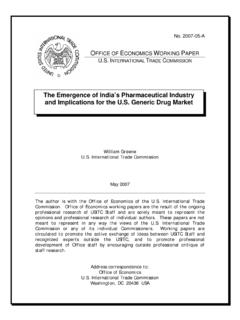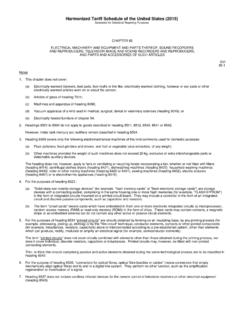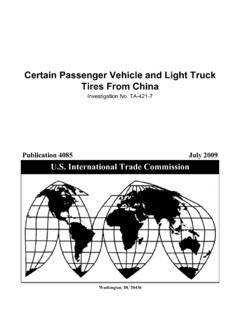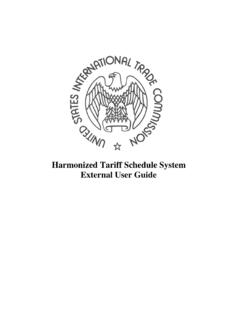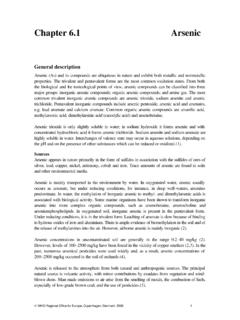Transcription of Use of the First Sale Rule for Customs Valuation of …
1 United States International Trade CommissionInvestigation No. 332-505 USITC Publication 4121 December 2009 Use of the " First Sale Rule" for Customs Valuation of Imports Address all communications to Secretary to the Commission United States International Trade Commission Washington, DC International Trade CommissionDirector, Office of EconomicsRobert B. KoopmanDirector of OperationsRobert A. RogowskyCOMMISSIONERS Shara L. Aranoff, Chairman Daniel R. Pearson, Vice Chairman Deanna Tanner Okun Charlotte R. Lane Irving A. Williamson Dean A. International Trade CommissionWashington, DC 20436 2009 Publication 4121 Use of the " First Sale Rule" for Customs Valuation of Imports Investigation No. 332-505 This report was prepared principally by the Office of Economics Project Leader Michael Ferrantino Co-deputy Project Leaders Nannette Christ and William Powers Office of Economics Alison Weingarden Primary Reviewers Cathy DeFilippo, Office of Investigations John Fry, Office of Industries Under the direction of Hugh Arce, Research Division, Office of Economics iPREFACE This report responds to the requirement in section 15422(c) of the Food, Conservation, and Energy Act of 2008 (2008 Act) (19 1484 note) that the Commission provide a report to the Congress containing certain information relating to the use of the First Sale method of valuing import transactions.
2 The report is based in large part on information concerning the use of the First Sale method that the 2008 Act required the Commissioner of Customs and Border Protection (CBP) to collect and transmit to the Commission on a monthly basis. The 2008 Act requires the Commission to transmit its report to the Congress no later than 90 days after receiving the last monthly report from CBP in this case, by December 24, 2009. This report includes tabulations of the number of importers using the First Sale rule and the value of imported merchandise covered, in the aggregate, by tariff classification, and on a sectoral basis, as well as descriptions and analyses of the frequency of such use. This report also contains information on the aggregate transaction value of all merchandise reported into the United States during September 2008 August 2009. iii EXECUTIVE SUMMARY What is the purpose of this report? Congress has requested that the International Trade Commission provide data and analysis about the use of the First Sale rule.
3 Little is known about the use of this rule due to the lack of historical data. What is First Sale? Where there are multiple sales of goods prior to their importation into the United States, the First Sale rule allows importers, in certain circumstances, to use the price paid in the First or earlier sale as the basis for the Customs value of the goods rather than the price the importer ultimately paid for the goods. Under law, the preferred method of valuing imported merchandise for Customs purposes is transaction value of the goods sold. When such transaction value is required and the goods are sold more than once before they are actually imported ( , in sales involving middlemen), the First Sale rule allows an earlier sale to be used in declaring Customs value as long as that sale can be documented as a sale for exportation to the United States and the importer meets all other Customs requirements.
4 Why use First Sale? Because the value attributable to earlier sales may be lower than that assigned to later sales, use of the First Sale rule can lower the duties paid by importers. Without additional data, however, it is not possible to determine Customs revenue loss or Customs value decrease in imports associated with First Sale use. How many importers used First Sale? Over the 12-month period investigated, from September 1, 2008, to August 31, 2009, a total of 23,520 unique importing entities reported using the First Sale rule. These account for percent of all importing entities. How frequently was the First Sale rule used? There are at least two ways to express the frequency of use. In terms of import value, of the $ trillion in total imports over the period, $ billion was imported using the First Sale rule, or about percent of total imports. Another indication of frequency is that importing entities used the First Sale rule on average in different months during the year, although no information is available on the average number of shipments imported using the rule.
5 What was the tariff classification, on a sectoral basis, of First Sale imports? Figure below shows sectoral use of the First Sale rule. Only the textiles, apparel, and footwear sector had both above-average First Sale use and an above-average tariff rate. Table below shows the top 10 HTS chapters (2-digit level) for which First Sale use was the highest, in terms of both value and the share of sectoral import value that used the First Sale rule. Is First Sale use associated with high tariffs? First Sale use is not always associated with high tariffs. For example, importers reported using First Sale when no duties would ordinarily be paid. These include approximately $ billion of imports from Canada, Mexico, and the Virgin Islands, accounting for 21 percent of all First Sale imports. There are also numerous cases of First Sale use for products that are unconditionally free of duty from all countries with normal trade relations status.
6 It is unclear how or why First Sale is being used in these instances. Although no data are available on the total number of pre-import transactions, it is possible that some importers may have reported First Sale use in situations where there was only a single sale. iv Figure Only the textiles, apparel, and footwear sector had both above-averageFirst Sale use and above-average tariff rate-20246810120123456 First Sale share of each sector's total import value (percent)Average tariff rate (percent)Other raw materialOther manufacturingPlastics & rubberElectrical equipmentMetals & productsMachinery, transportation & computersTextiles, apparel, & footwearFood & agricultureAverage = = size is proportional to the Customs value of sector's First Sale share of First Sale use and above-average tariff share of First Sale use and below-average tariff First Sale use by value. TABLE Top ten First Sale HTS chapters, by First Sale value and share (excluding chapters suppressed due to confidentiality) First Sale HTS Brief descriptiona Value (Thousand $) Share of (Percent)
7 Total 38,526,912 Top ten chapters by First Sale value 84 Machinery and computers 5,974,658 85 Electrical machinery 5,322,086 62 Woven apparel 1,964,764 61 Knitted apparel 1,896,745 27 Mineral fuels 1,588,250 22 Beverages 1,265,971 64 Footwear 1,072,720 30 Pharmaceutical products 1,026,425 73 Iron and steel products 925,683 42 Leather 853,792 Top ten chapters by First Sale share of total chapter imports 08 Fruits and nuts 821,855 42 Leather 853,792 22 Beverages 1,265,971 12 Oil seeds 138,300 06 Trees and flowers 100,852 03 Fish 639,192 62 Woven apparel 1,964,764 64 Footwear 1,072,720 67 Feathers 69,378 61 Knitted apparel 1,896.
8 745 Sources: CBP (September 2008 August 2009 First Sale data) and Department of Commerce. aFor descriptive purposes only. Official tariff descriptions available at refers to Customs value of general imports. v What is the aggregate transaction value of imports? As requested by Congress, the Commission estimated that $ trillion of imports used the transaction value method one of several methods of valuing imports from September 1, 2008, to August 31, 2009. Customs and Border Protection estimated that this method is used to value approximately percent of total imports. The transaction value method is based on the price actually paid or payable by a buyer for a good, plus adjustments for certain fees such as commissions, packing, royalties, and licensing fees. First Sale use is only allowed when the transaction value method is the method of Customs Valuation appropriate to an importation.
9 ViiABBREVIATIONS AND ACRONYMS 2008 Act Food, Conservation, and Energy Act of 2008 AMTAC American Manufacturing Trade Action Coalition CBP Customs and Border Protection CNIF Customs Net Import File Commission International Trade Commission ESCM Entry Summary Compliance Measurement FTA Free Trade Agreement HS Harmonized System HTS Harmonized Tariff Schedule of the United States nesoi not elsewhere specified or included NTA National Textile Association USITC International Trade Commission ixTABLE OF CONTENTS Page i Executive iii Abbreviations and vii Chapter 1. 1-1 Purpose, scope, and organization.
10 1-2 Approach and data sources .. 1-3 Chapter 2. Analysis of First Sale and Transaction Value 2-1 Number and frequency of importers that used the First Sale rule: Aggregate use .. 2-1 Number of importers that used the First Sale rule by sector .. 2-3 Value of imports that used the First Sale rule .. 2-7 The transaction value of imports .. 2-11 Biblio-1 Appendices A. Legislation .. A-1 B. Federal Register notices .. B-1 C. Summary of positions of interested parties .. C-1 D. Additional D-1 Figures Only the textiles, apparel, and footwear sector had both above-average First Sale use and above-average tariff iv Example of a series of transactions for which the First Sale rule might be applicable .. 1-1 The number of importers that used the First Sale rule was widely distributed across broad 2-5 By value, a few broad sectors accounted for most First Sale use.
